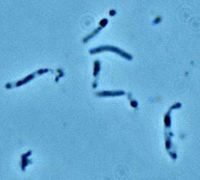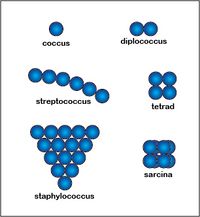Sporosarcina ureae
Classification
Domain: Bacteria
Phylum: Firmicutes
Class: Bacilli
Order: Bacillales
Family: Planococcaceae
Genus: Sporosarcina
Species
|
NCBI: Taxonomy |
Sporosarcina ureae
Description and Significance
S. ureae is a motile, Gram-positive sporeforming bacteria which is coccoid in shape,[1] its being a coccus is somewhat surprising given its close relation to the Bacillus genus, members of which are rod-shaped. S. ureae is distributed across the globe and is typically found in fertile soils and is especially prevalent in those containing high levels of urea. Its ability to grow in the presence of high amounts of urea is due to its ability to convert urea in soil to ammonia through the production of urease.[2] The ability for S. ureae to convert urea to ammonia offers a promising means by which to decrease fertilizer use in agricultural areas. This could be accomplished by rotating a plot of land from being an animal pasture, in which large amounts of urea would be deposited, and then being converted into a field the next year, at which time S. ureae would have converted the urea into ammonia for the new plants to use, thereby decreasing the need to apply ammonia to fields.
Despite their close relationship and numerous physical similarities, the unique biochemical aspects of S. ureae allow for the easy differentiation from Sporosarcina halophila; in particular, S. ureae can synthesize urease, convert nitrate to nitrite, and decompose tyrosine. Additionally, S. ureae lacks the ability to hydrolyze substances such as starch, pullulan, casein, and gelatin. [2]
Genome Structure
The genome of S. ureae was recently sequenced. Its genome contains 3.41 megabases and is circular in shape, consisting of a single chromosome.[3] The genome has been found to have a GC content of between 40.0-41.5mol%.[2] Among the better understood elements of S. ureae's genome is the SpoIIIE gene which is necessary for the formaton of spores. Interestingly enough, inserting this gene into B. subtilis (an organism of the same order of S. ureae, Bacillales) mutants which cannot form spores reverses the phenotype, allowing them to produce spores.[4]
Cell Structure, Metabolism and Life Cycle
S. ureae tends to form clusters--or sarcinae--of four or more cells. Colonies are circular, gray and opaque and slightly convex. The species is heterotrophic and explicitly aerobic.[2] The organism can grow in a normal nutrient broth, however it performs much better when in the presence of urea, which is likely due to the ease with which glutamic acid and glutamine can be produced from the ammonia S. ureae produces.[5]
S. ureae possesses the ability to form spores when faced with specific conditions. In particular, sporulation can be induced in an experimental setting by incubating at 22°C or less in a variety of specifically composed media. The spores are able to withstand temperatures of up to 80°C for no more than ten minutes.[2]
Ecology and Pathogenesis
S. ureae is widely distributed in soils, with fertile soils containing as many as 10,000 sarcinae/g. [6] While S. ureae is best adapted to a neutral habitat, it is tolerant to a pH as high as 10. While S. ureae does not have a specific symbiotic relationship per se, its conversion of urea to ammonia is most likely beneficial to most if not all plant life where it is found, as urea can be toxic to plants,[7] in addition to the fertilizing effect ammonia has on plants as a source of nitrogen. In a biogeochemical and environmental sense, S. ureae serves an important role in preventing urea levels from becoming too high in an area for species not tolerant to urea. Moreover, because S. ureae produces ammonia, which is a precursor to nitrite and nitrate in the nitrogen cycle,[10] the microbe may have an important impact on nitrogen cycling in an environment in which it is present.
S. ureae is not considered to be pathogenic to any organism at this time. After the organism was isolated from a bronchial biopsy of a child with cystic fibrosis, this notion was called into question. However, it was quickly determined that the existence of S. ureae in the biopsy was unrelated to the child's cystic fibrosis.[2]
References
1. Buchanan, R.E., and Gibbons, N.E., Eds. (1974) Bergey's Manual of Determinative Bacteriology, 8th ed., Williams and Wilkins Co., Baltimore, Md.
2. Claus, D., Fritze, D., Kocur, M., (2006) Genera related to the genus Bacillus–Sporolactobacillus, Sporosarcina, Planococcus, Filibacter and Caryophanon. The Prokaryotes , Vol. 4, 3rd edn (Dworkin M Falkow S Rosenberg E Schleifer KH Stackebrandt E, eds), pp. 631–653. Springer, New York, NY.
3. Nucleotide [Internet]. Bethesda (MD): National Library of Medicine (US), National Center for Biotechnology Information; [2017]. Accession No. NZ_CP015109.1, Sporosarcina ureae strain P17a, complete genome. [cited 2018 April, 14]. Available from: https://www.ncbi.nlm.nih.gov/nuccore/NZ_CP015109.1
4. Chary, V. K. & Piggot, P. J. Postdivisional synthesis of the Sporosarcina ureae DNA translocase SpoIIIE either in the mother cell or in the prespore enables Bacillus subtilis to translocate DNA from the mother cell to the prespore. J. Bacteriol. 185, 879–886 (2003).
5. G. Mörsdorf, H. Kaltwasser: Ammonium assimilation in Proteus vulgaris, Bacillus pasteurii, and Sporosarcina ureae. In: Archives of microbiology. Band 152, Nummer 2, 1989, S. 125–131, ISSN 0302-8933. PMID 2570557.
6. Pregerson, B.S. (1973). "The distribution and physiology Sporosarcina ureae". Master dissertation, California State University, Northridge.
7. Cooke, I.J. Toxic effect of urea on plants: Damage to plant roots caused by urea and anhydrous ammonia (1962) Nature, 194 (4835), pp. 1262-1263.
8. Kaiser, Gary E. “Size, Shapes, Arrangements, and Forms of Bacteria .” THE PROKARYOTIC CELL, DOMAIN BACTERIA: faculty.ccbcmd.edu/~gkaiser/SoftChalk BIOL 230/Prokaryotic Cell Anatomy/shape and arrangements/size_shapes_arrangements_forms/size_shapes_arrangements_forms_print.html
9. Shetty, Trisha. “Sporosarcina- Alchetron, The Free Social Encyclopedia.” Alchetron.com, 18 Jan. 2016, alchetron.com/Sporosarcina.
10. Smil, V (2000). Cycles of Life. Scientific American Library, New York.
Author
Page authored by Ben Bonson and Joseph Bernth, students of Prof. Jay Lennon at IndianaUniversity.




